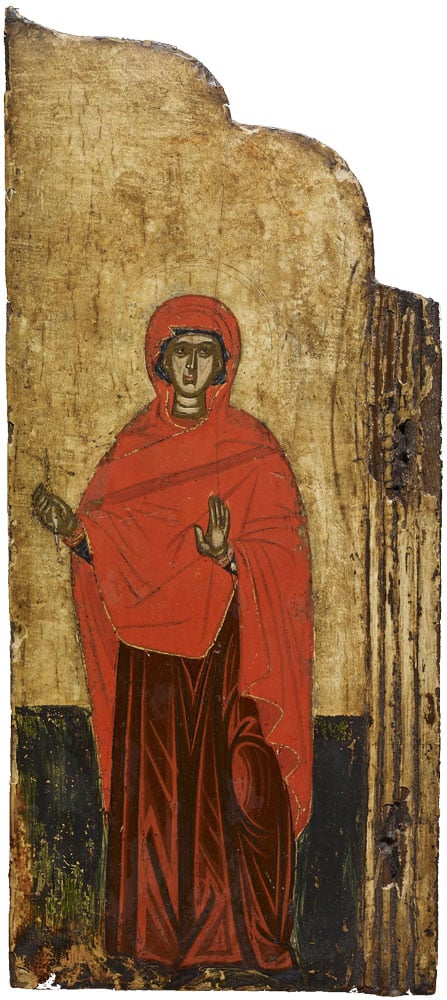The icon is painted in egg tempera and gold on wood primed with gesso. This small panel with a standing female saint was originally the left wing of a triptych, as indicated by its shape and the hinge marks on the right side. A zone of dark green colour denotes the ground on which she is standing, while the background was originally gold, now largely abraded. Also rubbed off is any inscription which might firmly identify the saint. The painter has used a preliminary incised drawing, particularly obvious on her garments and cross, the initial design of which was three centimetres longer than the final painted version of the panel. The back of the icon is polished, without using any priming.
She is clearly a martyr saint, as she holds a cross in her right hand. The other hand is held up. She wears a red tunic, over which is a bright red maphorion (mantle) edged in gold covering the head and shoulders. Her hair is gathered in a dark blue kekryphalos (headscarf).
On the basis of the colours of her vestments, one could suggest that the saint represented on this panel is St Marina (known as Margaret in the Western Church) who was executed in the late 3rd century under Diocletian. According to her Vita, her tunic turned red from the blood of her martyrdom, which explains her representation in red garments already in the Byzantine period (Baltoyanni 1998). However, there are examples of other female martyrs portrayed in red attire such as St Paraskevi. A martyr saint with a cross is a very common type (Walter 2000), making a definite identification very tricky.
The flesh of the saint is rendered in dark brown underlayer with planes of ochre on projecting features such as cheeks and forehead and very few white highlights discernible above the eyebrows, on the chin and neck. The drapery folds of her garments are painted in a rigid geometric way, while the outlines are dark and prominent. These features in conjunction with the use of the bright red colour on the maphorion of the saint seem to point to a 17th-century painter from northern Greece.
Literature: C. Baltoyanni, Conversation with God. Icons from the Byzantine Museum of Athens 9th–15th Centuries (exh. cat., The Hellenic Centre, London), Athens, 1998, 115, no. 18; C. Walter, Pictures as Language. How the Byzantines Exploited Them, London, 2000, XXII, 383–94; R. Cormack, Icons, London, 2014 (2nd ed.), 139, no. 108.
Eleni Dimitriadou
